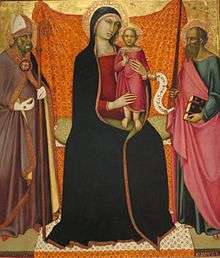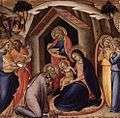Luca di Tommè

Luca di Tommè's painting of Madonna and Child, tempera on panel
Luca di Tommè (or Luca Thome) (c. 1330–1389) was an Italian painter active between 1356 and 1389 in Siena. He worked in the style established by earlier Sienese painters Duccio, Simone Martini, Pietro Lorenzetti and Ambrogio Lorenzetti. More than 50 works have been attributed to him. This large output contributed to the long-term survival of the decorative Sienese style well into the 15th century.
He worked in 1389 with Bartolo di Fredi and Andrea di Bartolo on a large commission for an altarpiece for one of the cathedral chapels in Siena.[1] He created his images using tempera on wood panels, in a manner typical of the 14th century.
Gallery
 The Raising of Lazarus, c. 1362
The Raising of Lazarus, c. 1362 The Flagellation of Christ, c. 1365
The Flagellation of Christ, c. 1365_-_Saint_John_the_Baptist_-_Google_Art_Project.jpg) Saint John the Baptist, late 14th century
Saint John the Baptist, late 14th century Adoration of the Magi, c. 1360-65
Adoration of the Magi, c. 1360-65
References
- ↑ Carola Hicks. "Luca di Tommè." Grove Art Online. Oxford Art Online. Oxford University Press. Web. 24 Feb. 2016
Further reading
- Fehm, Jr., Sherwood A. (1986). Luca di Tomme: A Sienese Fourteenth-Century Painter. Carbondale, IL: Southern Illinois University Press. Retrieved March 2010. Check date values in:
|access-date=(help) - A Reconstruction of an Altar-Piece by Luca di Tommè, by Sherwood A. Fehm, Jr, The Burlington Magazine (1973) page 463-466.
- Italian Paintings: Sienese and Central Italian Schools, a collection catalog containing information about Tommè and his works (see index; plate 23).
External links
 Media related to Luca di Tommè at Wikimedia Commons
Media related to Luca di Tommè at Wikimedia Commons
This article is issued from Wikipedia - version of the 10/12/2016. The text is available under the Creative Commons Attribution/Share Alike but additional terms may apply for the media files.